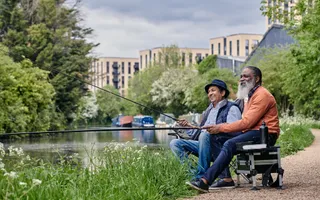Smith single-handedly, systematically and illegally changed the ecology of lakes in New Zealand during the second half of the 20th century.
Find a place to fish
Enter a town or postcode into our fishery search tool to find good local fishing spots
The charity making life better by water
Making life better by water
Keith Elliott, editor of 'Classic Angling' magazine, investigates the intriguing story of Stewart Smith.
Smith single-handedly, systematically and illegally changed the ecology of lakes in New Zealand during the second half of the 20th century.
Regrettably, there's more chance of catching a tilapia, peacock bass or even a red-bellied pacu if you fish certain Florida waters these days. The state has identified 22 non-native freshwater species breeding merrily away, plus dozens of others that will probably become part of Floridian fish-life before too long. Who's to blame?
Well, the pet trade, which finds Florida's climate ideal for breeding all sorts of exotics, which often escape, of course. Sometimes it's the clients themselves, who release a fish that has grown too big for a tank. The misguided might think it's much easier and kinder to dump a snakehead, cichlid or clown knifefish into the nearby canal than kill it. Arrant stupidity, you might say.
But how come many reading this will probably have an open waterbody nearby containing Wels catfish? How do you think they got there? What about the other non-native species we read about: topmouth gudgeon, zander, sterlets, ide and even an alligator gar, recently found beside a Welsh canal?
The culprits too often believe they are introducing variety into our fishing and get away with it, never considering what wider environmental damage they are causing. Think of rabbits and cane toads in Australia, Burmese pythons in Florida (again) and those Asian carp in the US, edging ever nearer the Great Lakes.
Most of these have been caused by ignorance of the potential consequences. But if you want possibly the worst example of piscatorial eco-terrorism, head for New Zealand.
Once upon a time, its waters held trout and around 50 local but small species, such as inangas, koaro, mudfish and the richly named redfin bullies. Few grow to much more than 6 inches. Now many New Zealand lakes and rivers abound instead with fish familiar to British anglers: tench, perch, rudd and others. Many local species are now severely endangered.
This was all driven by the obsession of just one man: Stewart Smith. One former official said, “He had more impact on New Zealand freshwater ecosystems than any other single human being. He was really one of our arch environmental criminals.”
As a boy in London in the 1920s, Smith was a keen angler, but fishing venues for a youngster in the capital were then very limited. He often fished alone, on the Grand Union Canal, the River Lea and the Lee Navigation.
He wrote in his diary, “My childhood in England was happy, largely due to those hours spent fishing.” But when he was 15, his father told Smith and his brother that they would be emigrating to New Zealand, alone. His childhood was over.
The idea of fishing for the local tiddlers didn't exactly stir the blood of early European settlers to New Zealand in the 1800s. Rightly or wrongly, they decided to put the ‘right sort of fish' into its crystal-clear waters. Trout flourished and grew large, with limited competition from native species.
But not everyone grew up on fly-fishing for trout. Some immigrants were far more familiar with coarse fish, and trout were seen as a fish for the posh. Attempts to bring in coarse fish were rebuffed, largely because they would compete with trout. This did not please Stewart Smith. As a member of the Communist party, he had a deep pathological hatred of social hierarchy.
Over four decades, beginning in the 1960s, he illegally released thousands of ‘alien' fish into the wild. Armed with oxygenated fish tanks, he roamed New Zealand, stocking a variety of freshwater fish into virgin waters.
By the time he died in 2008 at the ripe old age of 95, Smith had left a permanent legacy in his adopted country's waters. He was prosecuted at least twice but continued his illicit fish releases well into old age. He fitted his cars with oxygenated tanks and would stock wherever he could, almost always without the landowner's permission.
He smuggled fish eggs into the country by hiding them in his pocket while going through customs, and once, in the vegetable pantry of a passenger ship. He established new species in New Zealand from a handful of fish eggs that an associate sent to him in the post.
Smith chronicled his activities in hundreds of pages of personal notes. According to these, he was responsible for liberating more than 15,000 fish illegally into the wild between 1964 and 1987.
His campaign started with perch, a species that already existed in New Zealand. In 1905 a population had been legally introduced to Lake Rotoroa and had survived. Smith, with the help of two local boys, took perch from the lake and spread them around Auckland. His notes show he introduced hundreds into Auckland lakes in the 1960s.
In 1965 he widened his activities to include tench. He started with four, enough to establish a breeding stock in what he called his office pond, behind his garage. As his operation ramped up, Smith started to breed koi carp, gambusia and golden orfe. They all flourished without competition.
There had been no rudd in the southern hemisphere until Smith stocked them into a pond north of Auckland in 1969. Over 20 years he released more than 10,000, along with 2,300 tench, 1,000 perch and hundreds of koi, goldfish and orfe.
Authorities soon noticed a sudden appearance of rudd, never before seen in New Zealand. They knew who was responsible, because Smith brazenly bragged about his exploits. He was even featured in the ‘Auckland Star' newspaper under the headline, “Rudd Doing Well – Now for Gudgeon”, alongside his photo.
In 1970, his notes showed, he liberated more than 100 rudd into Lake Rototoa. They flourished so well that, 30 years later, Smith returned with perch in an effort to control the rudd.
But between 2003 and 2011, monitoring showed the resident dwarf inanga numbers had dropped by more than 99%. Alas, the species is now functionally extinct in the lake. It had also been a popular rainbow trout fishery, but this collapsed almost immediately after perch were introduced.
Smith was finally prosecuted for the first time in 1974. His fish were destroyed, his tanks poisoned, and his car confiscated, a setback which stopped his illegal fish liberations for four years. “Fascism is a long way from dead,” he wrote in his diary.
Smith's notes ended in 1988, when he was prosecuted once again, this time by the Auckland Acclimatisation Society. His fish were destroyed, his equipment and notes seized. He was fined $4,950 and his car again confiscated.
Although he had stopped making notes, there were numerous sightings of him around rivers and lakes in the early 2000s. Even though he was now an old man, he still hadn't finished. He even planned to stock the world-famous Lake Taupo with gudgeon.
How he managed to smuggle gudgeon into New Zealand remains unclear, but they were found by authorities in a pond near Helensville and exterminated. Smith told one friend that he had released gudgeon in dozens of other waterways, though it is unclear if this ever happened. Fortunately, there are no records of gudgeon being seen since, so it appears likely that this is one species Smith failed to permanently establish.
Curiously, an entire coarse fishing sub-culture had emerged in Smith's wake. A recent book, ‘Always Summer' by Peter Rolfe and Michael Pickford, catalogues the latter's successes with tench in New Zealand. Now, almost anywhere that you fish in the country, you will find Smith's legacy.
One person who knew him well said, “He was always yearning for that boyhood pleasure he enjoyed on the canals as a boy. He wanted to replicate that here. He genuinely felt that spreading these fish around was going to benefit people."
----------------------------------
"We're sharing this fascinating but shocking story as part of Invasive Species Week 2020. Stewart Smith released tens of thousands of fish in New Zealand, but even just a few people releasing one fish each can be the beginning of an enormous ecological problem.
"I can't help but think that a win-win outcome for Smith would have been to work with the New Zealand authorities to create a series of safe, totally enclosed stillwaters where people could have had a canal fishing experience. Instead he caused non-native species to firmly establish themselves in open watercourses, which sadly resulted in the unnatural loss of other species."
Read more about the different non-native species in the UK's canals and rivers
Enter a town or postcode into our fishery search tool to find good local fishing spots
Last Edited: 24 July 2025

Sign up to our newsletter and discover how we protect canals and help nature thrive







